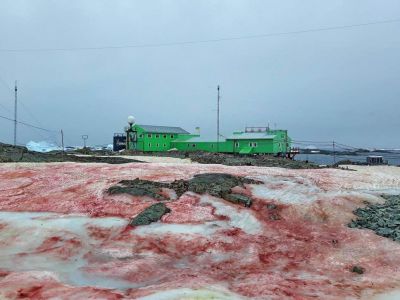Ukrainian scientists earlier this week released a rather gory looking set of pictures that showed the snow around their station in the Antarctic had turned red as blood.
The images, depicting watermelon-colored snow, were shared on the Facebook page of Ukraine's Ministry of Science and Education that revealed that the rather sinister-looking crimson red snow was a natural phenomenon.
The watermelon-colored snow was caused by the microscopic Chlamydomonas nivalis algae, the ministry revealed. Though the algae flourish in the snow when the weather is good, Ukraine's Ministry of Education and Science explained in the Facebook post that it does have dire implications for global warming.


The spread of the algae contributes to climate change as white snow reflects less sunlight and when it is crimson red it melts faster. Only colder temperatures can render the algae dormant.
The Ukrainian scientists explained that the algae can survive the extreme cold temperatures during the Antarctic winter and typically sprouts when warmer temperatures arrive in the summer between the months of October and February.
The snow looks like it was mixed with food coloring as the algae's cells have a red carotene layer which protects it from ultraviolet radiation and produces red spots in the snow like "raspberry jam, the Ukrainian ministry explained.
The watermelon snow also occurs in the Arctic, the Alps, and other high mountain ecosystems.


This month Antarctica experienced a nine-day heatwave and recorded its hottest temperature ever. What is even more shocking are the images released by NASA that revealed that a quarter of one Antarctic island's snow cover had melted during the heatwave.
As per the readings that came from the Esperanza Base, an Argentine research center, Antartica this month experienced temperature warmer than New York City. While temperatures in New York hit as high as 39 degrees, Antarctica hit 65 degrees, its hottest temperature ever recorded.
"I haven't seen melt ponds develop this quickly in Antarctica," Mauri Pelto, a geologist at Nichols College in Massachusetts, told NASA's Earth Observatory. "You see these kinds of melt events in Alaska and Greenland, but not usually in Antarctica."
The ice caps in Antarctica already have been melting at a rapid rate and could prove catastrophic for the millions of people who live along the world's coasts as Antarctica's ice sheets contain enough water to raise global sea levels by nearly 200 feet.









